Modern family
Adoption and foster care inspire the church to rethink love and family.
by Patrick David Heery
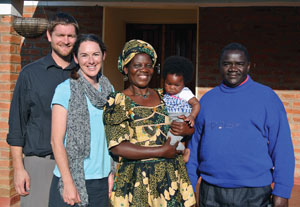
Long-term mission volunteers Tyler and Rochelle Holm with their adopted daughter, Mphatso, and Ruth and Levi Nyondo, who make up part of their church family in Malawi. Levi Nyondo is the general secretary of the CCAP Synod of Livingstonia, a PC(USA) partner church in the area.
At age 35, Jo Haas had, by most standards, achieved significant success. In the span of just a little more than a decade, she had graduated from college, risen to the position of vice president of operations at Ohio’s Center of Science and Industry, held a high-powered position with the Ford Motor Company, and been named the director of the Henry Ford Museum. But something was missing from Haas’s life.
“I hit that great age of 35 and realized that I had thrown myself headfirst into a career right after college, had advanced incredibly well, but had no significant other in my life,” she says. “What I wanted was to be a parent.”
This was no sudden realization for Haas. “Ever since I was really little,” she says, “I have wanted to be a mom. And I wasn’t going to wait for Prince Charming or rush into a partnership for the sake of parenthood. So I said, ‘I’m going to do this.’ ”
At first she tried artificial insemination, but after two years without success, Haas shifted to adoption. That took another couple of years—a long and laborious process of intense scrutiny, hope, and disappointment.
Haas remembers her social worker being brutally honest with her: “She told me, ‘As a single woman, you’re going to be the least desirable; you’re going to be on the bottom of the list.’ I thought to myself, ‘We’ll see about that.’ ”
Unabashedly public and, in her own words, “kind of zealous,” Haas networked fiercely until she got a call one Thursday morning about a woman interested in adoption who was due to give birth that Sunday. “At that point, you go into a frenzy,” Haas says. “Anything could happen. You just hold your breath.”
Haas, her mother, and her best friend were all on a plane three hours later. “I couldn’t even sit down. I just stood in the back of the plane and yapped at this poor flight attendant the whole time.”
As Haas waited in the hospital hallway, a nurse came out of a room and handed her a tiny, beautiful, screaming baby. “I fell in love right then and there. The minute that little boy was put in my arms, it was all over. What I had most wanted my entire life was now happening: I was a mother.”
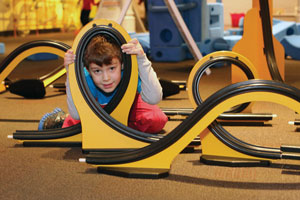
Jo Haas’s adopted son, Winston, enjoys a fun-filled day at the Kentucky Science Center in Louisville, where Haas works as the center’s executive director.
Now eight years old, Haas’s son, Winston, has become a precocious, imaginative, and highly extroverted child. He knows all about his adoption—knows that his mom chose him. “To this day, we have this little exchange,” Haas says. “Winston will look at me and say: ‘It’s OK, Mom. When you feel sad, you can just remember the best thing that ever happened to you.’ I then ask, ‘What’s that?’ And he says, ‘Well, the moment when I was born.’ Then I say: ‘When I feel sad, I think of the best thing that ever happened to me. And that was you, Winston.’ ”
Winston is just one of roughly 2 million adopted children in the United States, according to the US Census Bureau. That’s nearly 3 percent of US children. At the same time, approximately 400,000 children are living in foster care without permanent families. UNICEF estimates there are another 13 million children worldwide who have lost both parents.
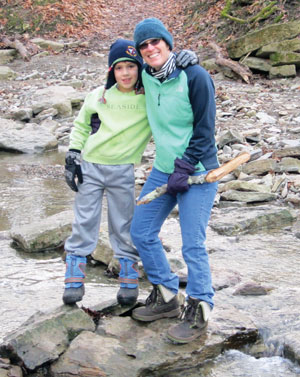
Jo Haas and her son, Winston, enjoy a hike outdoors. Haas is constantly taking Winston on hikes and introducing him to nature. Sometimes, they simply lie on their backs in their front yard and observe.
The people who adopt or foster these children vary considerably. Some are married; some are not. Some are of a different race or ethnicity from their child. Some are same-sex couples; others are interracial. But across all these differences, they have one thing in common: they love their children.
They also have to navigate a society—and a church—that typically doesn’t understand, talk about, or even at times embrace adoptive and foster-care families. Birth mothers (women who place their child with another for parenting) face even more misunderstanding and discrimination, as do single parents and interracial and same-sex couples.
Many of these families, however, are deeply involved with the church. They are college students, teachers, ruling elders, pastors, mission workers, and members in our pews. They and others are seeking to change how Presbyterians think about family.
A persisting stigma
Despite considerable advancements in recent decades, many voices in our culture would still have us believe that adopted children are not loved as much as biological children or that adopted children hate their biological parents, live under a cloud of mystery, and are not as emotionally healthy.
The facts are quite different.
People who foster or adopt generally have a deep appreciation for the gift of parenthood. After all, they have had to fight tooth and nail to make this child their own. As a result, nearly three out of four adoptive parents read or sing to their children every day. For biological parents, incidentally, that statistic drops to 50 percent.
According to the US Department of Health and Human Services, nine out of 10 adopted children ages five and older report positive feelings about their adoption and are generally healthy. For these children, there is little mystery about their origins. Thanks to legal and cultural reforms, every birth mother has a right to choose how much she wants to be involved in the child’s life. As a result, 67 percent of private adoptions are at least semi-open. And whether open or closed, adoptive parents now have an abundance of resources to help them explain adoption to their children.
In fact, 99 percent of adopted children ages five and older know they were adopted.
Their birth parents—subject perhaps to the most persisting stigma and enforced silence—are also, as a result of their choice, more likely to finish school, maintain employment, and eventually marry, while less likely to live in poverty, divorce, and have a repeat unplanned pregnancy.
Adoption professionals say that, for most, the decision to put their child up for adoption will be one of the most difficult and painful decisions birth parents ever have to make, and if they do go through with the adoption, it is out of love for the child.
Chosen families
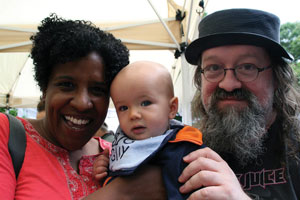
Margaret Aymer Oget with her husband, Laurent, and their son, Gabriel, whom they adopted 16 months ago
Margaret Aymer Oget had the birth parents in mind when she and her husband, Laurent, chose open adoption. In their mid-40s, they entered into an open adoption process that sounds a bit like online dating.
First, an adoptive family posts a public description online and in print. Then, potential birth parents review those profiles and contact them if interested. Even after the adoption happens, the birth parents are still a part of the child’s life. “The whole idea is that the birth mother and father are not secrets. There will be no 21-year-old search for ‘mother,’ ” Aymer says.
Being an interracial couple—Margaret is black and a native of the Caribbean; Laurent is white and native to France—they expected some challenges in the adoption process. An interracial couple waits, on average, eight months before being contacted. However, six days after posting their I Heart Adoption profile, they received a communication. The young parents were certain that adoption was the right decision for them at this time in their lives.
The result was Gabriel, a now 16-month-old baby with two loving parents and an extended birth family. “We’re in constant contact with the birth parents,” Aymer says. “We’re friends on Facebook. We are in contact with their extended family, including one set of grandparents. We send pictures and exchange presents. We’re going to have pictures of them in Gabriel’s room. They even came for his baptism.”
Aymer has no doubt, though, about her relationship with Gabriel. “He is my child. When I walk through the door, and he wraps himself around my neck, I am Mom,” she says.
That confidence is partly the result of her and Laurent’s family histories. “We both come from complicated families. We are both immigrants. And immigrants know something about creating family among strangers.” But her confidence is also directly related to her faith.
As an ordained teaching elder in the Presbyterian Church (U.S.A.) and an associate professor of New Testament, Aymer knows a good deal about the Christian theology of adoption—the idea that we are all adopted into the body of Christ and thus all part of an extended family of God. If that’s true, she says, then our notion of family cannot be limited to the nuclear unit of two parents and two biological kids.
It also can’t be limited by racial boundaries. Gabriel is a white baby with a black mother and a white father. “He does notice color,” Aymer says. “He will look at my skin and then his. I explain that that’s just how we’re made. When he becomes verbal, we’ll talk more about it.” Right now, Gabriel sees nothing more than a difference in pigment. But others, of course, see more.
Aymer says the history of African American women caring for white children in the United States colors how people see her and Gabriel. “They don’t assume I shouldn’t be with the child; they just assume he’s not mine.” But Aymer doesn’t let this faze her. “I am a black woman in the United States. We knew there would be issues. We made this decision consciously.”
While racism continues unabated in this country, Aymer’s focus is on this curious little boy who loves to turn things over and find out how they work—who loves to bang on the piano and flip through Desmond Tutu’s children’s book God’s Dream. This little boy, who’s just now learning to kiss, has made her fall deeper in love with her husband. And now she gets a chance to raise her son to be a white man who thinks critically about privilege and what it means to live ethically in this country.
‘This is our family, not our mission’
Rochelle and Tyler Holm will eventually have similar conversations with their adopted daughter, Mphatso. Long-term Presbyterian World Mission volunteers in Malawi, they have been witness to an HIV/AIDS pandemic that has robbed many children of their parents. But, unlike some other African countries, Malawi has complicated international adoption procedures, preferring to draw from local values to encourage extended families and communities to care for these orphans.
“This is a culture where you take care of your family members and neighbors. And here, your community is your family,” they say.
Though the Holms were licensed foster parents in the United States, it wasn’t until living in Malawi that these cultural values, combined with the desire for a child of their own, led them to fostering and then adopting Mphatso, one of the few children there without a caretaker. The name Mphatso means “gift,” and that is exactly how the Holms feel about their daughter, who came to them on Christmas Eve. “A lot of prayers brought Mphatso to us, not just ours but also all the prayers of our supporters in the United States and in the church,” they say.
Now Mphatso accompanies Rochelle while she collects water samples on Lake Malawi and Tyler while he’s teaching at the University of Livingstonia. “Can’t do that in the United States,” they say. “We love that she’s able to come with us. She loves people!” Mphatso has also helped bring the Holms into their Malawian community in new ways. “I now join the mom club at the back of the church with the other fussy little ones,” Rochelle says.
Some people, however, misunderstand the gift. “We are often told by well-meaning people that we’ll be so blessed for this good thing we’ve done,” Tyler says. “We really don’t like it when people say that. This is not charity. Our blessing is Mphatso. Our blessing is to raise her with God’s help. This is our family, not our mission.”
The Holms are well aware of the racial complexities that will exist for their family as white parents of a Malawian child. “Mphatso will grow up as a third-culture kid with a foot in Malawi culture and another in US culture. She’ll have to look for her identity as she grows.” With that in mind, the Holms will be teaching Mphatso to be bilingual and to know her culture.
“What’s the same for us is that she’s our daughter. It’s everything. It’s the most important part of who we are.”
Room in the church
The persisting question, in turn, for the church is whether our theology of family is large enough to include the Holms—or Margaret Aymer’s relationship with Gabriel’s birth parents, or a single mother like Jo Haas, or a birth mother who placed her child for adoption. Aymer, Haas, and the Holms have fortunately found supportive Presbyterian congregations. But not all adoptive and foster parents are so lucky.
Many congregations of course don’t actively exclude these parents. They’d never dream of turning someone away.
It’s more a matter of their silence. They’ve never met to discuss their baptismal theology and language of “family.”
“On the one hand, I go to a church with a lot of adoptive families, but, on the other hand, I don’t think I’ve ever heard a sermon about adoption,” Aymer says. “Where is the theological wrestling? How do we bring voice to this in the church?”
Learn more
Did you know that the Board of Pensions offers adoption assistance grants to church workers and their families? Find out more:
pensions.org (search “adoption”).
For more about adoption:
childwelfare.gov/adoption
To learn more about Rochelle and Tyler Holm and to support them in their mission through prayer and financial giving:
pcusa.org/holm-tyler-and-rochelle
Even simple phrases can, according to Aymer, reveal our bias. She purposefully, for instance, does not describe birth mothers as giving up their children for adoption. “The birth mother of my son did not give him up. She placed him with us to be his parents, in the same way that God placed Jesus with Joseph and Mary.”
It’s this more expansive concept of family that has assured Winston, Jo Haas’s son, that he is loved. Haas moved to Louisville six years ago in order to be closer to her parents and sister. “My sense is that family and community in this day and age can be very eclectic; it doesn’t have to be nuclear,” she says. “You can raise well-rounded and amazing kids with a village you intentionally create around you.” This village includes friends, the science center where she works, and Central Presbyterian Church, where’s she a member. That village is built around love.
“Here’s what I know: I love Winston more than anything in the world,” Haas says. “I know that I wanted nothing more than to have him in my life and to be his mother.”
Patrick David Heery is a PC(USA) teaching elder and the editor of Presbyterians Today.
Caring for God’s children
Foster parents, with the help of their church, create an unexpected family.
by Erin Dunigan
When John DeGarmo and his wife began taking foster children into their home 12 years ago, it felt like a call from God. At the time, they had three biological children of their own and realized quickly that welcoming foster children into their home would be a challenge not just for them as parents but for their children as well.
“When you take children into your home that come from many challenges and difficulties and sad stories, they come with a tremendous amount of emotional baggage,” DeGarmo says, speaking from his home in Jasper County, Georgia.
Those children have stayed with the DeGarmo family for as few as three days to as long as a year and a half—up to 11 children at one time, and for an average of five months. They have adopted three of them.
“We have had children who have been abused by family, abandoned by their parents, or born addicted to crack or meth,” says DeGarmo.
He admits it is not an easy calling.
Babies addicted because of a mother’s habit have to be weaned from the drug. “It is generally two weeks of nonstop screaming as the infant’s body is wracked with pain,” DeGarmo says.
One child they took in was a 13-year-old boy whose mother abandoned him under an overpass on a highway. They’ve had girls come to them who have been sexually abused.
“At many times, either my wife or I have decided that we weren’t going to do it anymore, because it is just too hard on our family,” DeGarmo says. As foster parents, they cannot even hire a babysitter to have a night off—when foster children are with them, it is a full-time commitment.
“But then the phone rings again, and we pray about it, and we always say yes,” DeGarmo says.
But it is no isolated yes.
“We of course rely heavily on God,” says DeGarmo. “But we couldn’t do it without our church.” The church family at Monticello Presbyterian Church has helped the DeGarmos with meals, diapers, clothes, and warm hospitality when they arrive on a given Sunday morning, multiple children in tow.
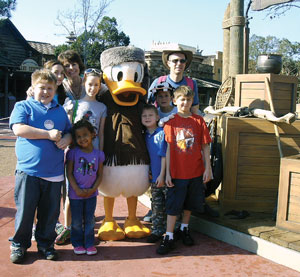
John DeGarmo and his wife with their children, some of whom are in foster care, at Disney World
“We had three boys who had come from a horrific situation—both the mom and the dad in jail for making meth in the house,” DeGarmo says. The boys had never been to Disney World. “So some church members helped us financially to take them.”
And that’s only one way, DeGarmo says, that congregations can help. “Foster kids often arrive with nothing but the clothes on their backs. If they do have anything, it’s often wrapped up in a black trash bag. To help, congregations can hold drives for clothing, food, and suitcases.” DeGarmo’s own church hosts monthly foster-care trainings, during which members provide a cooked meal, childcare, and prayer. The congregation, as a result of considerable training, also provides a safe space for biological parents and their children to meet and interact.
Explore
John DeGarmo travels the country counseling foster parents. He also is the author of multiple books and the host of a weekly radio show called Foster Talk with Dr. John. Learn more: drjohndegarmofostercare .weebly.com
It is exhausting work. But, as DeGarmo points out, there are still more children in need. “There are just under 500,000 children in foster care, and there is a huge shortage for homes. This is how I serve God, by taking care of his children.”
For DeGarmo, fostering these children, though, is more than the hard work involved; it’s more than even a ministry. It’s family. “When I bring a child into my house, that child becomes my child. I fight for that child, defend and nurture that child. And I grieve when that child leaves my house—every time.”
Adopting access
Advocates seek to make laws ‘an instrument of grace.’
by Judith Hugg
When David Nast experienced delayed speech development as a toddler, his adoptive parents and his school encountered a roadblock when they sought help.
The school contacted the adoption agency in New York for David’s medical records, but no information was given. New York remains one of several states that do not allow adoptees or adopting families access to birth records.
David’s adoptive parents got the answers they sought only when his birth mother found them through a national support group. “The birth mother showed us hospital records that indicated a trauma at delivery involving the umbilical cord and an oxygen insufficiency,” says David’s adoptive mother, Jane Nast. “Later, with speech therapy, he received excellent remediation.”
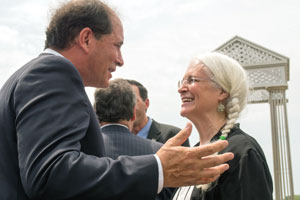
Joe Vitale, a New Jersey state senator and a Presbyterian, and Pam Hasegawa, a member of Kitchell Memorial Presbyterian Church in East Hanover, at the signing of the open-adoption-records bill into law
Now, thanks to the work of some influential Presbyterians and other advocates, adoptees in New Jersey will have easier access to their adoption records. Under the new law, which takes effect in 2017, adult adoptees will be able to obtain their birth certificates without needing a court order.
The Presbyterian effort behind the new law began in 1980 with Susan Andrews and Sim Gardner, copastors of Kitchell Memorial Presbyterian Church in East Hanover, New Jersey. Pam Hasegawa, herself an adoptee and member of Kitchell, in dialogue with her pastors, began soliciting support of other adoptees and birth parents.
Around that same time, Jane Nast and her husband were contacted by David’s birth mother.
“David’s mother contacted us when he was almost 14; she belonged to CUB (Concerned United Birthparents, the national support group) and had paid an ‘underground’ source to find him,” says Jane, a member of the Presbyterian Church in Morristown, New Jersey. “We decided we could not keep such a secret from our son.”
David and his adoptive parents agreed to meet his birth mother in person.
“The reunion was wonderful—no more secrets,” Jane says. As a result, the Nasts decided to try to find the birth mother of the other child they had adopted, a daughter named Karen.
“With [David’s] birth mother’s help, we were then able to find Karen’s birth mother—who was in our phone book and lived about five miles away,” Jane says. “Our reunions were so rewarding that, when Pam [Hasegawa] approached me, I began to work for access to adoption records in New Jersey.”
Jane began testifying before legislative sessions and became a member and eventual president of the American Adoption Congress. Meanwhile, Hasegawa wrote an overture to the 193rd General Assembly (1981), urging support of access to adoption records. The measure went from Kitchell Church through the Presbytery of Newton before being affirmed by the General Assembly.
The New Jersey grassroots adoption network expanded, striving to persuade legislators to open adoption records.
Proponents argued that such access would not only allow adoptees to learn about their medical and genetic histories and cultural heritage but also open the door to reconciliation with their birth parents and restore the basic right to receive a copy of their original birth certificate on request.
Opponents contended that such laws would impinge upon birth parents’ right to privacy—or on the right of adoptees and their adoptive parents not to be contacted by birth parents. Adoption laws across the country continue to evolve, with a recent shift to openness.
Reflecting on the legislative battles that have surrounded adoption records, Hasegawa recalls one source of inspiration: “I read an article referencing Jacob wrestling with God when he was journeying home to see his brother Esau after 20 years. Jacob insisted, ‘I will not give up until you bless me.’ It encouraged my faith that God would get us through the legislative obstacle course. I couldn’t foresee how the New Jersey laws would be amended into an instrument of grace, allowing original families to be reunited as were Jacob and Esau after their long separation.”
“This was the strongest demonstration of resilience I can recall in my years in the Senate,” says Joe Vitale, a New Jersey state senator and a Presbyterian. “Each session, we made every effort to keep the dialogue alive. At times, it didn’t seem like we were getting very far, but we knew we were always making progress.”
Judith Hugg is a member of the Presbyterian Church in Morristown, New Jersey, and author of To See the Sky: Vignettes of Grace.


